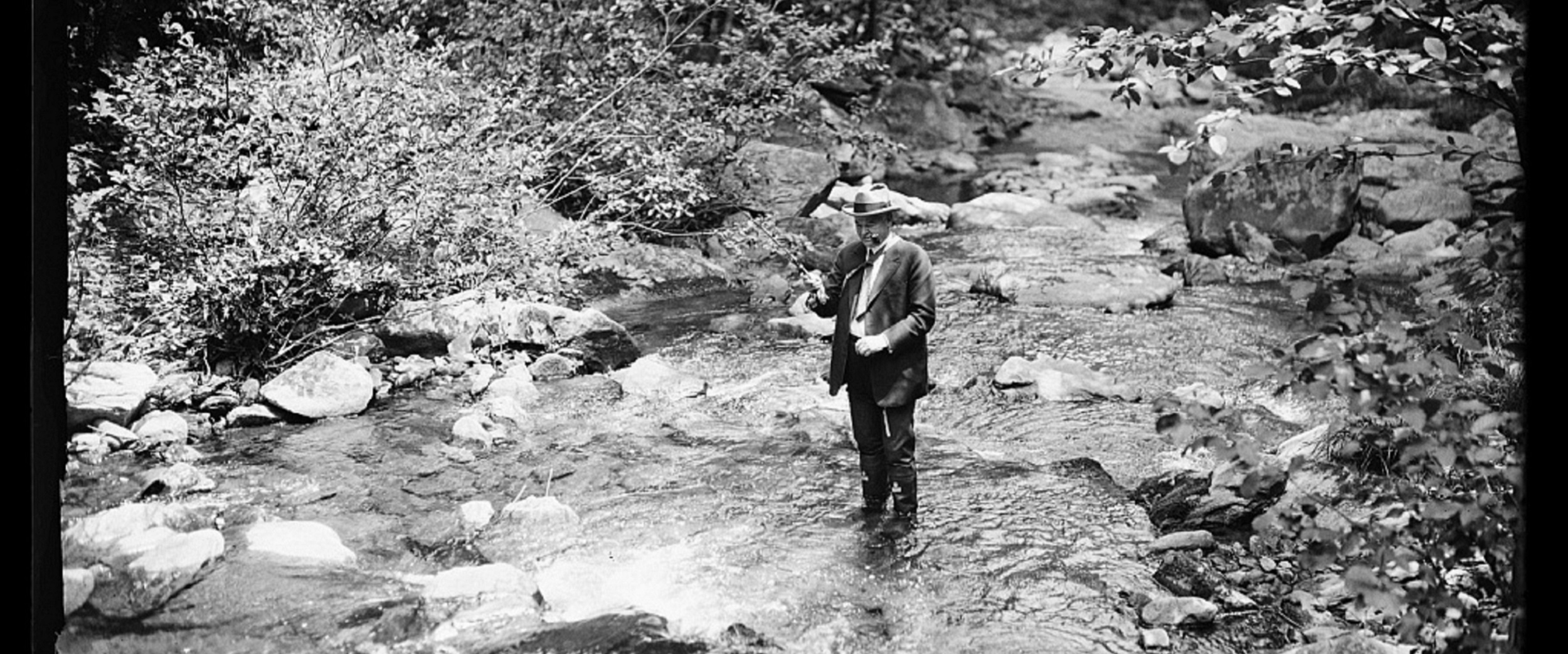In a 1990 New York Times article about fishing in Shenandoah National Park, Robert M. Poole wrote, “Herbert Hoover was a keen angler, and the Rapidan was his favorite stream. Friends recall that he would come straight from the White House, so excited by the sight of the stream that he seldom took time to change clothes before sloshing in.”
It is fitting to mention Herbert Hoover here, because fly fishermen today still flock to the Rapidan River, where Hoover built a summer retreat, now restored, that can still be toured today.
But popularity and crowds are not usually what fly fishermen seek. Where do you go to find that seclusion? A “where-to” guide to fishing the Shenandoah Valley would be so long it might not even fit on a Kindle. From Harper’s Ferry to Roanoke, the streams, rivers, lakes and ponds available to fishermen would take most of a lifetime to fully explore.
So to keep the topic manageable, let’s focus on one area: Shenandoah National Park. (And let’s note: August 25 – National Park Service Founders Day– is a “fee free” day in the park.)
Some general information about fishing in the Park may be found here. Note: Anglers are advised to research licenses, permits and regulations thoroughly. Regs can be complicated and, for example, those that apply to a stream within Shenandoah National Park may vary where the stream runs outside of the Park. Check with both SNP and the Virginia Department of Game and Inland Fisheries.
While the Park has about 70 streams to explore, here are five, tried-and-true runs anglers have enjoyed for years. (Water temperatures are of course high in August, but it’s not too early to plan your fall fishing!)
Jeremy’s Run—At some point you’ll wonder whether this is a fishing trip or an epic hike. The easiest access point is the Elkwallow Picnic Area near Milepost 22 of Skyline Drive. Jeremy’s Run is not known for huge fish, but native brookies are there in agreeable numbers. Follow the picnic area road until you come to a sign that says Jeremy’s Run Trail/Appalachian Trail. Take the AT to an intersection where a concrete post marks the trailhead. Or follow the stream itself.
The Rapidan—A classic mountain stream. Deep pools and fast riffles hold wild brook trout, usually seven to nine inches. The stream is catch and release only. VDGIF says: “Only single point hook, artificial lures may be used. No bait may be in possession while fishing these waters. All trout must be immediately returned to the water unharmed. No trout may be in possession while fishing these waters.” Access the lower sections of the Rapidan “from the bottom” by Route 662, a pretty rough road where four-wheel-drive is advised, to where it ends at the Park line. Alternatively, go west on Route 231 from Madison. Turn left at Banco onto Route. 670 and then left onto Route. 649. Continue on Rt. 649 till you reach the headwaters.
North Fork Moormans—Native brook trout and even the occasional brown may be caught here. Note that it’s catch and release only. You might hook a rainbow in the lower section, but the headwaters are normally considered better fishing overall. From Skyline Drive, park at the lot just south of Milepost 87, then hike down North Fork Moormans River Road, which runs alongside the river. The lower section may be accessed by following Rt. 614 west of White Hall till it dead ends at the Charlottesville Water Authority/Shenandoah National Park boundary.
Big Run—A trout blogger once wrote: “This is a place every fan of brook trout should visit once they are in good enough shape to survive the trip.” It is the biggest stream in the Park and probably the most challenging to reach. But stories of 12-inch brook trout are common enough to give them credence. One common route: Park at the Doyles River parking area just south of milepost 81 on Skyline Drive. Follow the Big Run Loop Trail a bit more than two miles to the Big Run Portal Trail. You have to hike another half hour or so, but some of the better fishing can be found near the confluence of Rocky Mountain Run and Big Run. Get in more fishing time by toting backpacking gear and spend a night or two.
Madison Run–Smallish brook trout may be landed here, mostly on the steam’s lower and middle sections – about three to four miles from Skyline Drive. From the top, park on Skyline Drive at the Brown Gap parking area near milepost 83, and hike down Madison Run Road. You can also fish it from the bottom by way of Route 708.
Two final notes: Murray’s Fly Shop in Edinburg, now in its 55th year of operation, is an iconic resource for fishermen in the Valley. Call 540-984-4212.
And: While not within Shenandoah National Park, the Shenandoah River was in May of this year called “One of America’s Five Best Rivers for Fly Fishing.” Travel writer Randy Yagi wrote: “The main tributary of the Potomac, the Shenandoah River is one of the premier rivers for smallmouth bass in the Eastern U.S. and among the top rated fly fishing rivers in the country. Stretching more than 55 miles across the Shenandoah Valley with two prominent forks extending approximately 100 miles each, the Shenandoah River features year-round fishing with the most productive months being April through September. Great fishing action can be enjoyed all along the Shenandoah but particularly on the snakelike South Fork.”
Library of Congress photo.





